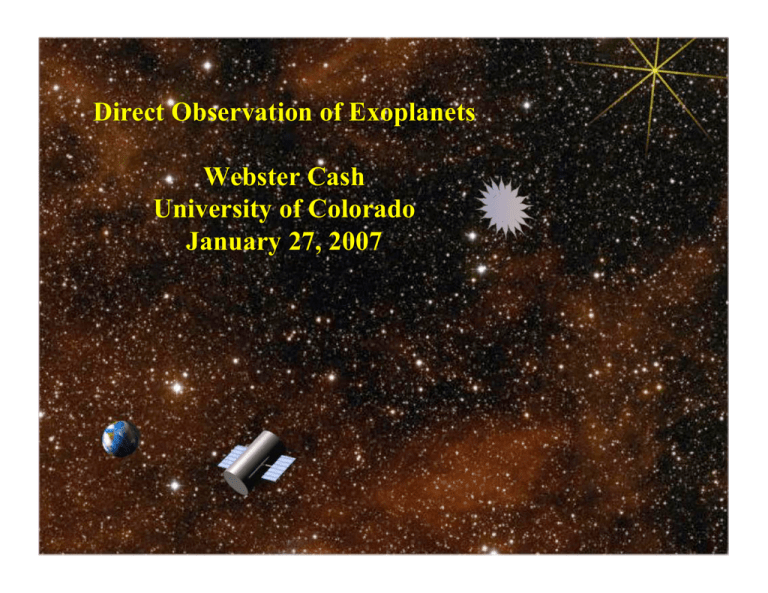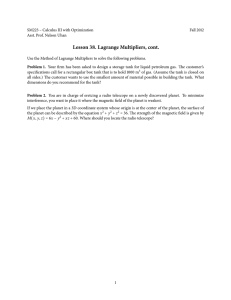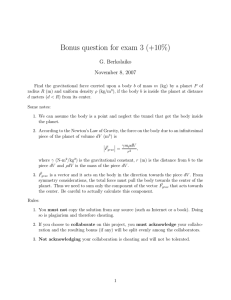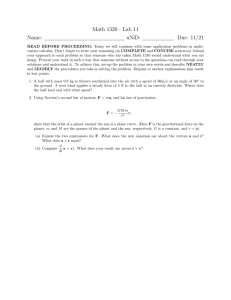Direct Observation of Exoplanets Webster Cash University of Colorado January 27, 2007
advertisement

Direct Observation of Exoplanets Webster Cash University of Colorado January 27, 2007 1 Planet Finding: Extinguish the Star Contrast ratios better than 10 billion to one needed across a tenth of an arcsecond. Wow. That’s tough! However will we get it done??? Courtesy of N-G 2 Terrestrial Planet Finder JPL’s Answer TPF-C TPF-I Must Be Done in Space Because of Atmospheric Twinkle 3 TPF-C Visible Light Coronagraph Planet light Planet Light Starlight Stop scatter starlight 4x8m Space Telescope 4 TPF-I & Darwin Mid-Infrared Interferometer Multiple Large Cooled-IR Telescopes Combine Beams Null Out Star at One Angle Constructive Interference at Nearby (Planet) Angle 5 Occulters Planet Target Star NWD Starshade JWST Telescope big enough to collect enough light from planet Occulter big enough to block star – Want low transmission on axis and high transmission off axis Telescope far enough back to have a properly small IWA No outer working angle: View entire system at once 6 Fly the Telescope into the Shadow 7 Dropping It In 8 Why Haven’t Occulters Been Baselined All Along? Because Everybody knows that diffraction around an occulter is too severe 9 Occulters Several previous programs have looked at occulters – First look by Spitzer (1962) Used simple geometric shapes – Achieved only 10-2 suppression across a broad spectral band With transmissive shades – Achieved only 10-4 suppression despite scatter problem http://umbras.org/ BOSS Starkman (TRW ca 2000) 10 Extinguishing Poisson’s Spot Occulters Have Very Poor Diffraction Performance – The 1818 Prediction of Fresnel led to the famous episode of: – Poisson’s Spot (variously Arago’s Spot) – Occulters Often Concentrate Light! Must satisfy Fresnel Equation, Not Just the Fraunhoffer Equation Must Create a Zone That Is: – Deep – Wide – Broad Below 10-10 diffraction A couple meters minimum Suppress across at least one octave of spectrum Must Be Practical – Binary – Size – Tolerance Non-transmitting to avoid scatter Below 150m Diameter Insensitive to microscopic errors 11 The Apodization Function Found this in April. Extended in June. This Function Extinguishes Poisson’s Spot to High Precision A (! ) = 0 for !<a and A (! ) = 1 " e # ! "a $ "% & b ' ( n for ! >a 12 Binary Shape 13 Shadow Depth 14 Doing the Math (Cash, Nature 2006) The Residual Intensity in the Shadow is By Babinet’s Principle Es = 1 ! E A Is = E 2 s where EA is field over Aperture So We Must Show n 2" a ik ! 2 2" ' ik ! 2 ik ! s cos# ik ! s cos# $% ! $ a & , $ $ ( ) k . 2 2 e 2 F e F ! d ! d# + 2 2 e 2 F e F e * b + ! d ! d# / = i 2" F . 0 0 / 0 a 0 1 F is distance to starshade, s is radius of hole, k is 2π/λ To one part in C " 10!5 15 Contrast Ratio Preceding integral shows the contrast ratio is – # n! % F ! & R=' n n) * '- a b + 2" , n $ ( (. 2 – n is an integer parameter, typically n=6 To keep R small a~b – this is the reason the occulter has that symmetric look 16 Starshade Tolerances Position Lateral Distance Several Meters Many Kilometers Angle Rotational Pitch/Yaw None Many Degrees Shape Truncation Scale Blob 1mm 10% 3cm2 or greater Holes Single Hole Pinholes 3cm2 3cm2 total 17 Lab Studies 18 Tall Poles Deployment of 35m shade to mm class tolerance Acquiring and holding line of sight Fuel usage, orbits and number of targets Stray Light – particularly solar 19 Scatter Control View Nightside 20 21 22 23 Deployment 24 Triple Layered Micro-meteor Protection 25 Alignment acquisition & hold 26 L2 Orbit Favorable 27 Planning the Mission 28 New Worlds Discoverer Could launch with JWST in 2013 All formation flying requirements on starshade – JWST passive, just points Meets cost cap and technology readiness requirements Three year mission – over 100 lines of sight Capable of detecting Earth to 10pc Spectroscopy of Jovian planets Earth spectroscopy marginal Constitutes a low cost TPF Not Selected on this round 29 Simulated Solar System 30 Discoverer Science Simulations Starshade Shadow Jupiter Exo-Zodiacal Jupiter Saturn Mars Earth Saturn 31 Additional Contrast from Telescope 10-8 10-7 10-6 32 NWD Sensitivity Planet Mass (ME) 100 10 D NW Habitable Zone @ c 7p pc 10 1 c 4p 0.1 1.0 Semi-Major Axis (AU) 10.0 33 New World Observer Architecture After NWD Proposal Submitted NGST looked at full-up system 4m Telescope Diameter Breakpoint Two Starshades – one small and fast Very Powerful Scientifically Cost comparable to other missions on table 34 The First Image of Solar System Uranus Galaxies Zodiacal Light Jupiter Saturn Neptune 10 arcseconds 35 90° 80° 70° 60° 50° 40° 30° 20° 10° 36 Spectroscopy R > 100 spectroscopy will distinguish terrestrial atmospheres from Jovian with modeling H2O O2 CH4 NH3 S. Seager 37 Spectroscopic Biomarkers Water Oxygen Ozone Nitrous Oxide Methane Vegetation Necessary for habitability Free oxygen results only from active plant life Results from free oxygen Another gas produced by living organisms Life indicator if oxygen also present Red edge of vegetation at 750nm 38 Photometry Calculated Photometry of Cloudless Earth as it Rotates It Should Be Possible to Detect Oceans and Continents! 39 NWO Science Result of Nature interviews Many discussions with press and other interested parties It is Life Seeking that EVERYBODY wants Just finding water planets enough, but its not what motivates the public Can there be a bigger or more important question for astronomers? New Worlds Observer can do it $2-3 Billion and 10 years 40 The New Worlds Imager Earth at 2 0 0 km resolution. Oceans, continents and cloud s are visib le. A sim ulated exo-p lanet at 5 0 0 km resolution. 41 TRUE PLANET IMAGING 3000 km 1000 km 300 km 100 km Earth Viewed at Improving Resolution 42 Solar System Survey at 300km Resolution 43 NWI Concept starshades 50,000km primary collector combiner collector craft 1500km field star collimator planet collimator to combiner field star beams Delay Lines – Mixers - Detectors planet beams 44 Hypertelescope Problem How Many Apertures Needed? One per pixel (no!) Cost control of multiple craft Formation Flying to Tolerance Labeyrie has worked on this Amazing telescope even without starshades 45 Sims Established that information is present in the fringes and detectable. How do we invert into images? Is this enough? 46 Lunar Option Planet Imaging is exciting enough to justify the expense level Appropriate Level of Challenge for 20+ years from now Starshades in Orbit 1m Collectors Delay Lines, Beam Combiner, Detector 1m Collimator Surface of Moon 4m Telescope 47 Tradeoff Pro Con Infrastructure Moon Stable Bench Refuel Starshades Moon Rotates 100km class delay lines 48 Conclusion By 2013 By 2025 H2O O2 49








